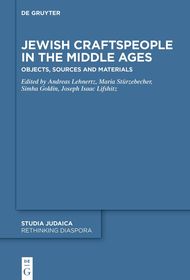
Jewish Craftspeople in the Middle Ages
Objects, Sources and Materials
Sorozatcím: Rethinking Diaspora; 5;
-
5% KEDVEZMÉNY?
- A kedvezmény csak az 'Értesítés a kedvenc témákról' hírlevelünk címzettjeinek rendeléseire érvényes.
- Kiadói listaár EUR 119.95
-
49 749 Ft (47 380 Ft + 5% áfa)
Az ár azért becsült, mert a rendelés pillanatában nem lehet pontosan tudni, hogy a beérkezéskor milyen lesz a forint árfolyama az adott termék eredeti devizájához képest. Ha a forint romlana, kissé többet, ha javulna, kissé kevesebbet kell majd fizetnie.
- Kedvezmény(ek) 5% (cc. 2 487 Ft off)
- Kedvezményes ár 47 262 Ft (45 011 Ft + 5% áfa)
Iratkozzon fel most és részesüljön kedvezőbb árainkból!
Feliratkozom
49 749 Ft

Beszerezhetőség
Még nem jelent meg, de rendelhető. A megjelenéstől számított néhány héten belül megérkezik.
Why don't you give exact delivery time?
A beszerzés időigényét az eddigi tapasztalatokra alapozva adjuk meg. Azért becsült, mert a terméket külföldről hozzuk be, így a kiadó kiszolgálásának pillanatnyi gyorsaságától is függ. A megadottnál gyorsabb és lassabb szállítás is elképzelhető, de mindent megteszünk, hogy Ön a lehető leghamarabb jusson hozzá a termékhez.
A termék adatai:
- Kiadás sorszáma 1
- Kiadó De Gruyter
- Megjelenés dátuma 2025. december 31.
- ISBN 9783110787986
- Kötéstípus Keménykötés
- Terjedelem450 oldal
- Méret 230x155 mm
- Nyelv angol
- Illusztrációk 25 Illustrations, black & white; 25 Illustrations, color 700
Kategóriák
Rövid leírás:
The series focuses on the evolution of Jewish language, literature, communal life and religious ideology outside of the Land of Israel and in relation to it. The approach is inter-disciplinary with an emphasis on mutual influences between Jews and their non-Jewish environment. The series welcomes studies that span different periods and a variety of geographical areas.
TöbbHosszú leírás:
The significant participation of Jews in medieval European daily life culture and economy is common knowledge in modern Jewish Studies. We know that Jews used the same objects as Christians did. Scholars therefore are speaking of the shared or entangled culture of both groups. But in general it is assumed that most of these objects were made by Christian craftspeople, organized in guilds. However, Jewish craftspeople existed as well and are testified by manifold different sources. Yet, this field to date has not been studied adequately. Sources providing evidence of medieval Jewish craftspeople are rather scarce at first glance, especially in Northern Europe. In the Mediterranean, most regions with Jewish populations have a much broader base of sources. We can find Jews in medieval Europe working as turners, dyers, window makers, weavers, goldsmiths, armorers, dicers, belt makers, glaziers, playing card makers, bricklayers, tailors, watchmakers and mouse trap makers ? to mention only a few. A number of questions arise from these references, for example regarding the most common professions, the customers or the relationship with Christian craftspeople. In order to answer these questions, an interdisciplinary approach is necessary.
Több



